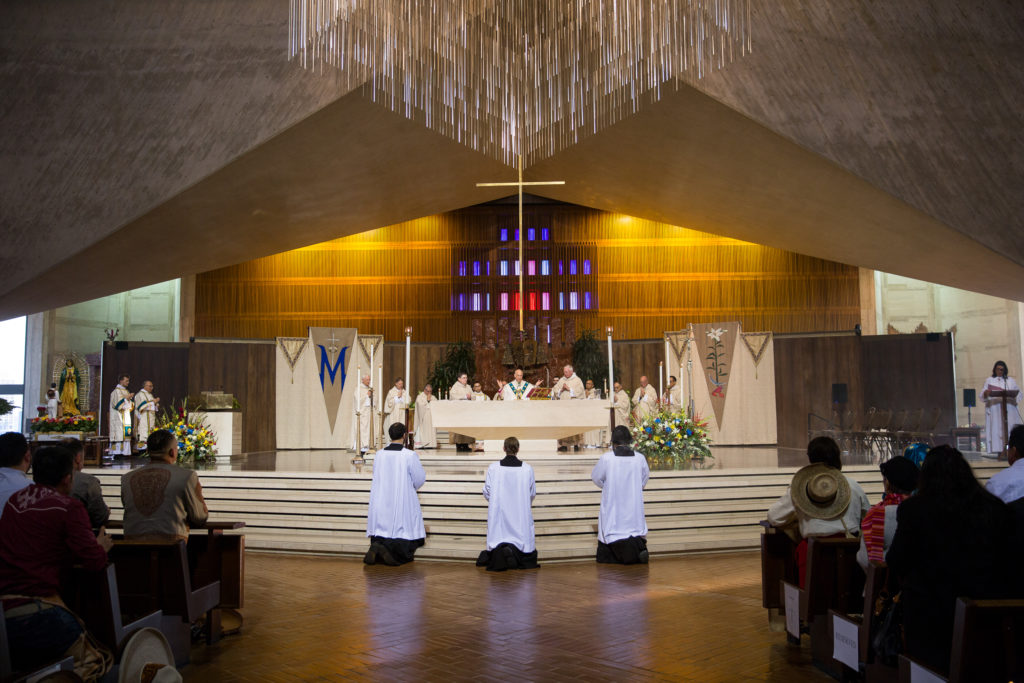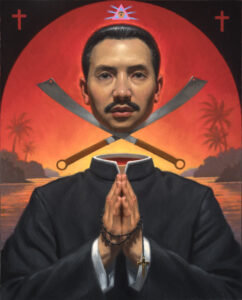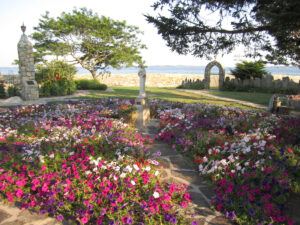How does an artist approach the annals of history, walk amongst the hallowed treasures of Western society, and dare to deposit a work which may remain?
We can’t know what history will say, but we do know the circumstances which often surround the begetting of masterworks: institutional support, financial patronage, initial exposure, and ultimately an artist who does not shrink from embracing the weight of history.
On December 8 at St. Mary’s Cathedral we may have witnessed just such a confluence of forces: a new, magnificent collaboration between the Benedict XVI Institute, the Archdiocese of San Francisco, and the composer Frank LaRocca which birthed the new The Mass for the Americas.
The Mass of the Americas came into being this December 8 on the Feast of the Immaculate Conception. It was also the 25th anniversary of the “Cruzada Guadalupana”, the annual 12-mile pilgrimage through the streets of San Francisco in honor of our Lady of Guadalupe.
And so in honor of Our Lady, Frank La Rocca created what he described as an “intertwined tribute to our Lady of the Immaculate Conception as Patroness of the United States and our Lady of Guadalupe as Patroness of the Americas”.
Whereas new classical music concerts are often happy to draw a dozen attendees, thousands packed the pews at the Mass of the Americas, making it (in one sense) one of the best attended new music events of the 21st century.
And yet in the hands of a lesser composer, it might have been a very public disaster.
The immense crowd entered the cathedral tired from the long walk, excited by the Aztec feathered dancers performing on the Cathedral plaza, entertained by Caballeros on horseback and in many cases making the final march up the aisle to the altar of Our Lady of Guadalupe on their knees.
The reverence of the faithful attending was palpable. But would they really want to sit through a full choral setting at the end of their journey? Would they experience high sacred music as an awe-inspiring beauty or something alien to their cherished community and culture?
These tensions made the Mass of the Americas’ setting as risky as it was ingenious.
Just before the Mass was scheduled to begin, the Aztec dancers processed up the aisle, the large heuhuetl drums pounding, the smaller teponaztli drums keeping time, leg rattles made of shells and seeds shaking, along with native flutes and horns, surely a very strange prelude for a Mass in the high sacred music tradition of the Church.
While the display was impressive, it was also long, and as it died away the unfocused murmur of the tired congregation was evident.
It was precisely in this moment of disarray and disconnect that La Rocca’s quiet Introit began: a stunning combination of hushed strings and gentle tolling hand-bells, murmuring rather than shouting devotion to Christ. A sudden and telling wave of silence rolled across the crowd of the faithful: La Rocca had their attention, with expressions from surprise to the outright riveted visible from this watcher’s vantage point.
It was a fitting rebuke to those who fear our sacred music tradition is somehow unsuited to the contemporary diverse Faithful.
Archbishop Salvatore Cordileone was the principal celebrant, a leader whose vision and patronage set Frank La Rocca to work as the Benedict XVI Institute’s composer-in-residence on “The Mass of the Americas”. Written in Latin, English, Spanish, and the Aztec Nahuatl language, one could easily imagine that La Rocca was simply asked to do too much and to wrangle together too many disparate elements in a liturgical setting neither he nor anyone else had ever attempted.
It was ultimately the unabashed reverence and deep individual devotion of La Rocca’s approach which would carry the day, somehow wrapping up a potentially overambitious idea into a Mass setting which was intimate, personal, deeply considered, and unapologetically beautiful.
If the Introit was hushed in nature, the remainder of the Mass setting moved us all through a narrative arc, all within Frank’s clearly identifiable musical style.
The Kyrie – half in Spanish and half in English – pleaded with simple earnestness, the tolling strings in the accompaniment drawing the congregation further into the penitential aspect of the text.
The Gloria – in Latin – springboarded from the ascetic musings of the Kyrie into an optimistic setting which alternatively proclaimed and soared, giving the skilled sopranos in the choir a chance to move confidently into their upper registers.
One discordant note: I would have preferred that the Psalm setting, like the Credo, was spoken not sung. Instead, the choice was made to use a second amateur choir to sing a GIA-published setting which (like much of such music) simply could not live up to the full dignity of the liturgy, let alone La Rocca’s deeply considered work or (naturally) a 16-voice professional choir.
I observed, and so did many around me, that a vital bridge between folk culture and the high culture of the liturgy was being rebuilt in La Rocca’s work. It reminded one of the impressive examples of authentic liturgical and aesthetic enculturation in the south American Baroque sacred music tradition.
As the Mass of the Americas continued, an absolutely stunning setting of the Ave Maria in the Aztec Nahuatl language washed over us. Set for soprano voice, violin, marimba and organ, this luminous musical exploration seemed to emerge out of the earth itself. The work somehow represented both an ancient people turning to God and the simple prayer of a single person, as if spoken from the heart for the very first time.
La Rocca writes of the piece: “When Our Lady of Guadalupe spoke to Juan Diego, it was in his native tongue. And so I thought it was important to include the predominant language spoken at that time, in that part of the New World, into the Mass of the Americas. And this same language, spoken also by Aztec priests in their rituals, is now blessed by the one Catholic faith as it is brought into the celebration of Holy Mass for the Cruzada Guadalupana.”
Soprano Arlyss Hays learned the work quite late in the rehearsal schedule, yet nevertheless delivered a polished and deeply human performance for which the young singer deserves ample praise.
The closing recessional – La Rocca’s Alma Redemptoris Mater – functioned as a stylistic bookend with the opening Introit, with the handbells returning to a similar instrumentation and a comparatively hushed and reverent atmosphere. The opening lines of the work – with tenors and sopranos singing in octaves – echoed plainchant as the strings slowly evolved into a fugal reflection of the opening melodic material, in turn, to be imitated by cascading entrances in the full choir.
During the brief postlude, the Alma Mater Redemptoris melody continued on the organ and the strings began to croon the La Guadalupana. And somehow miraculously, they harmonized.
The Archbishop later confided that he had to hold back tears, such was the power of the Mass of the Americas; many were similarly visibly moved.
For a composition to become something for the ages, the biggest chasm is between the first performance and the elusive and the (for most) unattainable second performance. Here again, the vision and patronage of Archbishop Cordileone and the Benedict XVI Institute are inspiring. “We’re looking to take this on a Marian cathedral tour,” Maggie Gallagher, executive director of the Benedict Institute, told me.
It’s an immense undertaking for a small startup organization, but already planning is in the works (donors willing) for Our Lady of Guadalupe Cathedral in Dallas. A professionally recorded CD is also in the works. Meanwhile, you can listen to the Mass here and judge for yourself.
What beyond the piercing witness of divine Beauty are the lessons of this first great musical effort from the Benedict XVI Institute for Sacred Music and Divine Worship?
First, that the great Catholic tradition is alive and well, and is only waiting for courageous pastoral leadership and visionary patronage to continue its great story where it most belongs: in the bosom of the Church.
Second, that the lack of such creative enterprises by those most qualified to support and compose them leave us at the mercy of aesthetic ignorance and mediocrity.
Finally, on a personal note as a composer, I cannot help but underscore the privilege it was to attend this event. It had all the feeling of a turning tide and inspired me and the other artists in attendance to labor anew in our own vineyards. A new Mass setting which somehow brings an atmosphere of devotion and quietude to a congregation of thousands, all while inspiring the other artists in attendance to continue to faithfully create their own new work, is a musical project which was worth shepherding into existence.
Frank La Rocca, the Benedict XVI Institute, the Archdiocese of San Francisco and their great Archbishop Cordileone all deserve praise for boldly reembracing the Church’s great witness of Beauty in a difficult age. It is, simply put, among the most essential work that can be done in our world today.
Dr. Mark Nowakowski (www.marknowakowski.com), is Assistant Professor of Music at Kent State University. A prolific composer of sacred and concert works, his 2017 Naxos “American Classics” release – “Blood, Forgotten” – was praised as “at once fierce, haunting, and mystical” by Gramophone magazine.
Listen to the Aue Maria in Nahuatl below. Or see and hear the main parts of the Mass of the Americas here.




